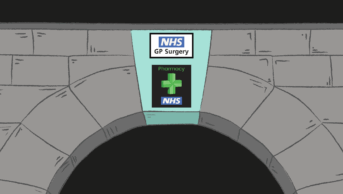One of the most greatly anticipated community pharmacy services is finally underway in England.
Following years of discussion, after health secretary Sajid Javid first mooted the idea in 2021, pharmacies in England opened their doors to the NHS Pharmacy First service on 31 January 2024.
The service means pharmacists, using patient group directions (PGDs), are now able to supply specific treatments for seven common conditions: sinusitis; sore throat; infected insect bites; impetigo; shingles; uncomplicated urinary tract infections (UTIs) in women; and acute otitis media.
The move is largely motivated by the need to reduce pressure on overstretched GP services, as outlined in NHS England’s ‘Delivery plan for recovering access to primary care’ in May 2023’, which committed up to £645m to expand the services offered by community pharmacy.
For many financially-squeezed pharmacies, the payments of £1,000 per month for providing the service, plus the £15 fee per consultation, offer a ray of hope at a time when lack of funding has been blamed for widespread closures.
Pharmacies were also incentivised to sign up early — by the end of January 2024 — to offer the service, with a one-off payment of £2,000.
As a result, more than 93% of community pharmacy contractors signed up to deliver the service ahead of launch day, health secretary Andrea Leadsom said in a written statement on 26 January 2024.
The significance of Pharmacy First in raising the profile of the sector among patients is not lost on those providing the service.
It is “a crucial first step in recognising and properly funding the enormous amount of healthcare advice that community pharmacies provide to the public every day and in establishing and funding community pharmacy as the first port of call for healthcare advice”, says Helen Musson, chief officer at Community Pharmacy Hertfordshire.
But, as Pharmacy First officially launches, is community pharmacy ready to start offering the service that it has long called for?
Workforce concerns
A survey by the Pharmacists’ Defence Association (PDA) of its members suggests the majority of contractors do not feel ready to provide the service.
The survey of 3,500 employed and locum pharmacists, carried out between 5 January and 14 January 2024, found that just 5% of respondents felt confident that their pharmacies would be able to deliver the service by the launch date. Two-thirds (66%) of respondents were not confident that their pharmacy would be ready, while 29% of respondents were unsure.
Although 68% of pharmacists agreed with the principle of Pharmacy First and 84% thought that it could improve patient care, the PDA’s survey revealed that 87% of pharmacists believed it could damage the already fragile workforce situation if not introduced or resourced properly.
The most common concern was about queues and unmanageable workload, which was cited by 88% of respondents, while 78% of respondents feared that a hurried launch and marketing campaign would raise the public’s expectations and lead to an increase in violence and abuse.
Pharmacy teams are already stretched to their limit. NHS data show that the number of full-time equivalent (FTE) pharmacists decreased by 13% to 2,646 in 2022, compared with 2021, while the number of FTE pharmacy technicians had declined by 17% in the same period. Pharmacists have been on the Home Office’s ‘shortage occupation list’ since March 2021, making it easier to recruit from overseas.
This will clearly put huge workforce pressures on the pharmacist and pharmacy teams
Hitesh Patel, chief officer at Community Pharmacy KCW
Hitesh Patel, chief officer at Community Pharmacy KCW, which covers Kensington, Chelsea and Westminster, tells The Pharmaceutical Journal that getting ready for the Pharmacy First service is “a mammoth undertaking” for pharmacy teams. He adds that, when delivering the service, the clinical pathways and PGDs could take “up to 30 minutes per patient consultation”.
“This will clearly put huge workforce pressures on the pharmacist and pharmacy teams, which are already struggling with medicine shortages and a broken community pharmacy contractual framework contract.
“The fee for each consultation would be wholly inadequate if it were to take 30 minutes as a norm,” he says.
Service training
Patel also notes the significant training burden that has been placed on pharmacies looking to offer the service.
“Whilst this is a welcome and exciting time for the development of community pharmacy, there will be nervousness about the size of the challenge,” he says.
“The training required for the pharmacist is huge and pharmacy teams will also need to be trained and ready for the launch date.”
Training was another issue raised in the PDA survey, with only 1% of respondents having completed all of the Pharmacy First training at the time of the survey and 36% having only completed some of it. A majority of 63% had completed none of the training.
In preparation for the launch, NHS England and the Centre for Pharmacy Postgraduate Education (CPPE) developed the Pharmacy First self-assessment framework, which aimed to help pharmacy professionals identify gaps in the “knowledge, skills and behaviours” required to deliver the service.
The assessment directed pharmacists to further resources, including clinical examination training, which was launched in March 2023, and workshops to support ear, nose and throat (ENT) examinations.
But Patel says the number of pharmacist training places that NHS England had offered on CPPE ENT workshops were “derisory — probably a tenth of what was actually needed”.
Patel adds that local pharmaceutical committees (LPCs) in north-west London have funded an extra 360 CPPE ENT training places, which will “delay the training of some pharmacists into February”.
Although this could lead to “a small proportion of community pharmacists who may not have upskilled their practical ENT skills”, he says there is “no doubt that they will still be able to follow the clinical pathways and give patients a safe and secure consultation”.
Other LPCs that The Pharmaceutical Journal spoke to said they were also offering free training ahead of launching Pharmacy First.
Stephen Noble, chief executive of Community Pharmacy Dudley, says five LPCs in the West Midlands (Birmingham & Solihull, Dudley, Sandwell, Walsall and Wolverhampton) joined together to put on four training days for pharmacists, with another three days planned in February and March.
“The days include an ENT session, with otoscope training, plus a services session which covers Pharmacy First, contraception and hypertension. As you can imagine, these have been costly to put on, but all the LPCs considered this an investment in their pharmacists’ futures,” Noble says.
The PDA survey revealed that access to training is a particular concern for locums, with 45% of respondents saying that as locums they had to give up regular paid shifts or otherwise self-fund the time to attend Pharmacy First training.
“From an LPC level in Cornwall and the Isle of Scilly, we recognise locums as an integral part of our workforce so with Devon and Somerset we have put on an additional 450 free training places to supplement CPPE’s training,” says Nick Kaye, chief executive of Community Pharmacy Cornwall.
Phased introduction
Despite these challenges, Patel has “full confidence” that pharmacy teams are ready to offer the service.
“Community pharmacies always adapt and scale up to any challenges, but this has come about so quickly that it will put a huge strain on pharmacy teams,” he says.
One suggestion to deal with this tight timescale, made by 74% of PDA survey respondents, was a phased introduction of the new clinical pathways.
PDA made this suggestion at a meeting with David Webb, chief pharmaceutical officer for England, and senior Department of Health and Social Care (DHSC) civil servants on 17 January 2024, but the request was declined.
We knew from day one that the implementation of Pharmacy First would be challenging for all involved, especially during the busy winter season
Fin McCaul, regional representative for the North West negotiating team and chair of the service development subcommittee at Community Pharmacy England
A spokesperson for the DHSC says: “More than 93% of pharmacists have signed up to deliver the seven common conditions as part of Pharmacy First and we have met with the PDA to discuss their concerns and highlight the support available”.
According to Community Pharmacy England (CPE), which negotiated the Pharmacy First contract with NHS England and the DHSC, the timescale was the best option they had.
“We knew from day one that the implementation of Pharmacy First would be challenging for all involved, especially during the busy winter season,” says Fin McCaul, regional representative for the North West negotiating team and chair of the service development subcommittee at CPE.
“But this was the only offer on the negotiating table and all the pharmacy owners on our committee, many of whom still work in their community pharmacies on a day-to-day basis, felt that we had to make it work.”
McCaul adds that most pharmacies “will already be offering much of the advice and support covered by the Pharmacy First service, but now they will get paid to provide it, helping to get that vital funding flowing into pharmacies”.
GP collaboration
An important aspect of setting up the service will be collaborating with GP colleagues, says Raj Matharu, chief executive of Community Pharmacy South East London.
He tells The Pharmaceutical Journal that the service would rely on building “trust and confidence” between community pharmacies and GP practices.
“You may find that, even locally, there are different ways that patients are referred to pharmacy and we’re going to have to navigate that.
“After the first few referrals, if GPs see that patients are being seen and looked after, the confidence and trust will build, and it will hopefully generate referrals into other low-acuity conditions.”
But GP Connect — the IT intended to make this collaboration easier by providing pharmacists with access to patient records — is being implemented later than planned.
NHS England said in October 2023 that by January 2024 pharmacists would have access to GP patient records and be given the capability of adding to them following a Pharmacy First consultation.
However, a statement from CPE on 25 January 2024 said that enhanced access to GP records will be provided “within a few weeks of launch” and pharmacists will be able to add information to GP records “during February 2024”.
“GP Connect is going to be crucial to community pharmacy, but the go-live date has been pushed back,” says Matharu, but adds that the service “is still safe to provide” as pharmacists will have access to the National Care Record Service.
The main concern, he says, is updating the GP record. “We’ll just have to use NHS emails until we have GP connect live,” he says.
This is a big opportunity for community pharmacy and opportunities come wrapped up in hard work
Raj Matharu, chief executive of Community Pharmacy South East London
Regardless of this issue, Matharu is ultimately optimistic about the future of Pharmacy First.
“This is a big opportunity for community pharmacy and opportunities come wrapped up in hard work.
“Community pharmacy will get there one way or another. We always do because we’re innovative and creative individuals and we’ll make it work,” he says.
With only 1% of respondents to the PDA survey believing the current implementation plans are adequate, it is clear there is a big challenge ahead.
Gareth Jones, director of corporate affairs at the National Pharmacy Association, says that although he believes community pharmacy will “rise to the challenge” of delivering Pharmacy First, “no-one is under any illusion that this will be easy, especially in the early days of implementation”.
However, Pharmacy First could open the doors to an exciting future for community pharmacy and patient care in England.
Click here to view our collection of resources on minor ailments, which have been mapped to cover the conditions specified by the Pharmacy First service.
3 comments
You must be logged in to post a comment.




I think it's an attempt at finding a new model or solution to help the overburdened NHS and for that I support the originators of the scheme. However,how it will work on a day to day basis in an already stretched community pharmacies will remain to be seen. It's success will need to be audited and patients and staff delivering the service views gathered and some 'tweaks' may be needed. Expecting need to be managed, staff will need ongoing support,training and guidance. Without this reflection cycle the scheme may struggle to be delivered consistently.
In view of the statistics about the readiness of pharmacies to undertake this service, why has CPE agreed to it in the first place?
It highlites once again the callous indifference this contractor-led panel has for the ever increasing workplace pressure forced upon individual pharmacists.
No wonder pharmacist retention and recruitment is under pressure!
Pharmacy First is based on the old fashioned ,no appointments, GP morning and evening surgery, which was the GPs main function in those days.
Pharmacy First has now taken on that role but instead of 2 one hour surgeries Pharmacy First has condemned the pharmacist to a full day open surgery ,for a measly £1000 per month , and a £15 consultation fee.
Hardly a just reward for a Pharmacy Qualification and all the responsibility plus the cost of indemnity insurance.